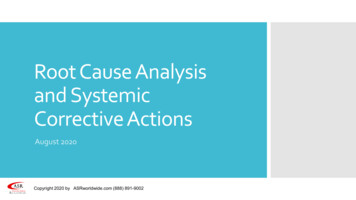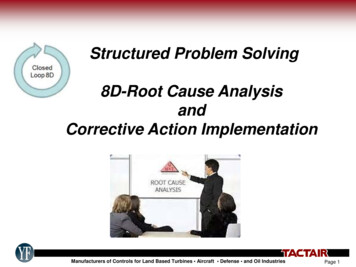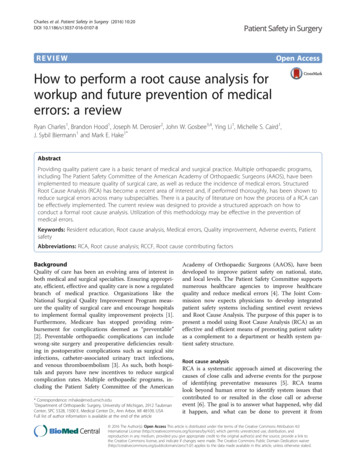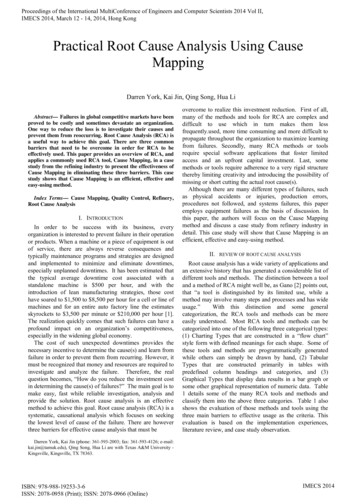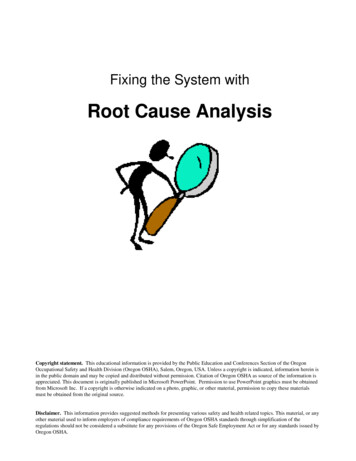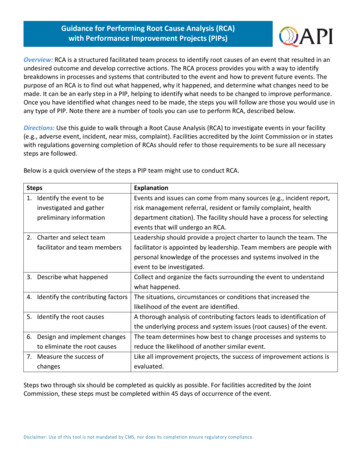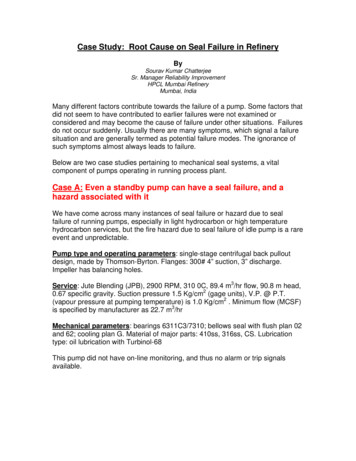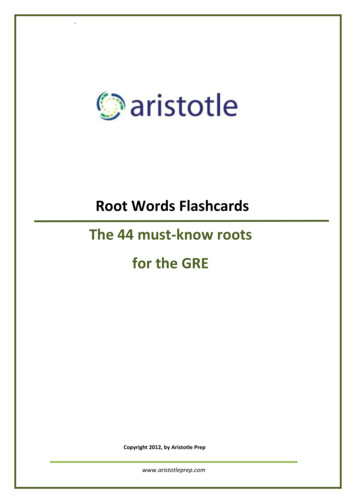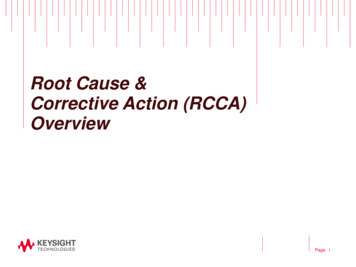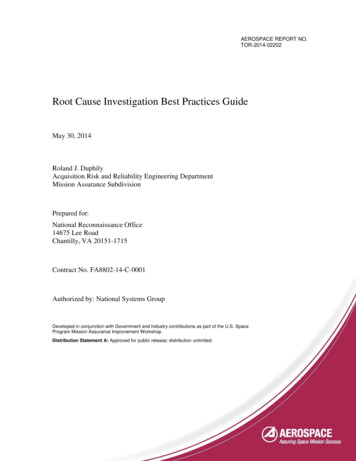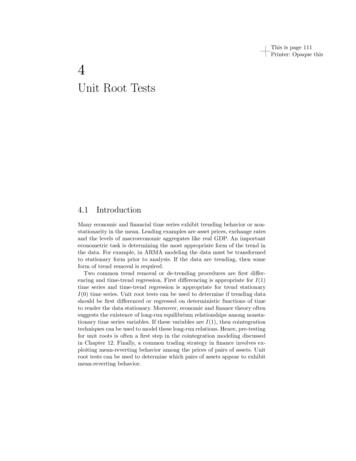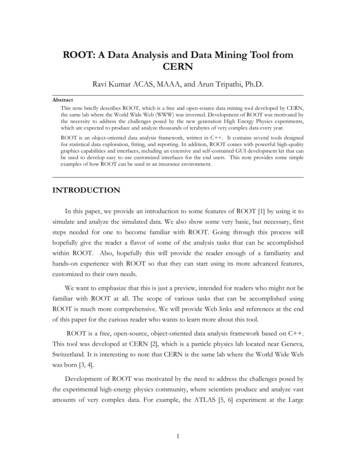
Transcription
ROOT: A Data Analysis and Data Mining Tool fromCERNRavi Kumar ACAS, MAAA, and Arun Tripathi, Ph.D.AbstractThis note briefly describes ROOT, which is a free and open-source data mining tool developed by CERN,the same lab where the World Wide Web (WWW) was invented. Development of ROOT was motivated bythe necessity to address the challenges posed by the new generation High Energy Physics experiments,which are expected to produce and analyze thousands of terabytes of very complex data every year.ROOT is an object-oriented data analysis framework, written in C . It contains several tools designedfor statistical data exploration, fitting, and reporting. In addition, ROOT comes with powerful high-qualitygraphics capabilities and interfaces, including an extensive and self-contained GUI development kit that canbe used to develop easy to use customized interfaces for the end users. This note provides some simpleexamples of how ROOT can be used in an insurance environment.INTRODUCTIONIn this paper, we provide an introduction to some features of ROOT [1] by using it tosimulate and analyze the simulated data. We also show some very basic, but necessary, firststeps needed for one to become familiar with ROOT. Going through this process willhopefully give the reader a flavor of some of the analysis tasks that can be accomplishedwithin ROOT. Also, hopefully this will provide the reader enough of a familiarity andhands-on experience with ROOT so that they can start using its more advanced features,customized to their own needs.We want to emphasize that this is just a preview, intended for readers who might not befamiliar with ROOT at all. The scope of various tasks that can be accomplished usingROOT is much more comprehensive. We will provide Web links and references at the endof this paper for the curious reader who wants to learn more about this tool.ROOT is a free, open-source, object-oriented data analysis framework based on C .This tool was developed at CERN [2], which is a particle physics lab located near Geneva,Switzerland. It is interesting to note that CERN is the same lab where the World Wide Webwas born [3, 4].Development of ROOT was motivated by the need to address the challenges posed bythe experimental high-energy physics community, where scientists produce and analyze vastamounts of very complex data. For example, the ATLAS [5, 6] experiment at the Large1
ROOT: A Data Analysis and Data Mining Tool from CERNHadron Collider (LHC) [7] at CERN will be generating over 1,000 terabytes of data per year.And this is just one of the experiments running at LHC.ROOT is being used widely by several experiments in high-energy physics, astrophysics,etc. [8]. In terms of the cost of these research projects, and the people involved, the ROOTuser community comprises a multibillion dollar “industry,” with the labs and the userslocated pretty much across the whole planet.WHY ROOT?ROOT is a very appropriate tool for use by actuaries and other insurance analysts whodo ad hoc data analysis and predictive modeling type work.ROOT is a framework that is specifically designed for large scale data analysis. ROOTstores data in a very efficient way in a hierarchical object-oriented database. This database ismachine independent and highly compressed. If one loads a 1 GB text file into a ROOT file,it will take up much less disk space than the original text file. ROOT also has tools tointeract with data in a very efficient way. It has built in tools to do multi-dimensionalhistograms, curve fitting, modeling and simulation. All these tools are designed to handlelarge volumes of data.Conversely, relational databases (databases where the data is organized as tables androws) were originally designed for transactional systems and not for data analysis. Thus arelational database is very good for use in a policy administration system, which looks at onepolicy at a time, or claim administration system, which looks at one claim at a time. But,when one is interested in segmenting the data across all the policies or across all the claims, arelational solution falls apart. In order to make the relational solution work for large scaledata analysis, we use the brute force method. A typical brute force method will involveadding considerable computing power, adding sophisticated I/O capabilities such as cache,etc., adding numerous indices to tables, creating additional summaries of the data (likeOLAP cubes), and other similar techniques. If one loads a 1 GB text file into a relationaldatabase, it will take up multiple gigabytes to just store the data. When one further tweaksthe database for performance with additional indices, pre-summaries and such, the original 1GB data would have exploded to something very large. Most (if not all) of the commercialsoftware for data analysis is built for accessing data from relational databases. Thesecommercial tools cannot overcome the fundamental flaw in the way data is stored (tablesand rows) except by using brute force.Casualty Actuarial Society E-Forum, Winter 20082
ROOT: A Data Analysis and Data Mining Tool from CERNSome data analysis tools are very memory intensive. Some data analysis tools are veryI/O intensive. Some data analysis tools are both memory intensive and I/O intensive (likemost commercial business intelligence tools operating on relational databases). In thesesystems, even if the data grows on a linear scale, the performance of the system degenerateson an exponential scale. Thus, these systems are not easily scalable, whereas ROOT storesand retrieves data in an optimal way that is conducive for data analysis. It avoids mostmemory issues and I/O performance issues by seamlessly buffering the data betweenmemory and storage. One can thus get a very reasonable throughput from ROOT even froma small PC (all the analysis reported in this paper was done on a PC). A laptop with ROOTas a data analysis tool may be able to give a better performance than a powerful mainframeusing one of the commercially available data analysis tools. ROOT can thus be a solutionadopted by one person in an insurance company. Once proven, it can be easily extended toan entire team of data analysts or as a corporate wide solution. A ROOT solution is veryhighly scalable.ROOT might be an appropriate solution even for smaller data sets. Typically, predictivemodeling and ad hoc data analysis involve presenting the data in different graphical/tabularforms. These presentations are best done in a notebook device. This is one of the reasonswhy Excel is very popular among the actuaries. Using Excel, one can play with the data andonce a story emerges from the data, it becomes easy to share the story with the rest of theteam. This concept can be loosely termed as interactive computing. When one wants to doanalysis on one column in an Excel spreadsheet, the entire spreadsheet must be read intomemory. Like Excel, other technologies also suffer similar inefficiencies. When data is storedas tables and rows as in a relational database, subsets of the data cannot be accessed ormodified in an efficient way without touching other parts of the data. The design of ROOTallows access to subsets of data without the need to touch the rest of the data. An entireROOT file can be read sequentially if all the information must be processed. With no dataexplosion issues, a ROOT file can also be read randomly to process just a few attributes ifthat is what the analysis requires. ROOT is thus able to give us interactive computingcapabilities where other solutions fail.There are many other reasons why ROOT is an appropriate tool for predictivemodeling. But efficiency in storing and accessing the data is where ROOT stands out fromany other tool that is in the market today.Casualty Actuarial Society E-Forum, Winter 20083
ROOT: A Data Analysis and Data Mining Tool from CERNHOW TO GET ROOTROOT can be downloaded under GNU Lesser General Public License [9] from theROOT download page [10]. Installation instructions are also provided there. A ROOT user’sguide [11], complete class reference [12], tutorials [13], and useful how-to’s [14] are alsoavailable online. A searchable ROOT user forum, called Root Talk [15], is a useful resourceto find answers to several of the questions an average user might come up with.Any references in this paper to the ROOT user’s guide correspond to version 5.16,which is the current production version of ROOT as of the writing of this paper.Throughout this paper, we will sometimes provide the CPU time taken for a givenanalysis. These times were measured on a PC running Windows XP, with a 1.73 GHz IntelPentium M processor, and 1 GB of memory. Also, all these analyses were performed usingCINT, the C interpreter provided by ROOT. See chapter 7 of the ROOT users guide tolearn about CINT.STARTING ROOTIf ROOT was installed correctly, a tree-shaped icon, shown in Figure 1, shouldautomatically appear on your Windows desktop.Figure 1: The ROOT shortcut icon on Windows desktop.In order to start ROOT in Windows, just double-click on this icon. This will start theROOT console, which is shown Figure 2.In Unix/Linux environment, ROOT can be started by issuing the following commandfrom the command line: ROOTSYS/bin/rootROOTSYS is the environment variable pointing to the directory where ROOT wasinstalled. If the directory containing the ROOT executable is already in the system path, thenCasualty Actuarial Society E-Forum, Winter 20084
ROOT: A Data Analysis and Data Mining Tool from CERNone just needs to type “root” from command line to start ROOT. Regardless of theoperating system, the resulting ROOT console will appear the same (as shown in Figure 2).Figure 2: The ROOT console.LOADING DATA INTO ROOTROOT provides TTree and TNtuple classes to store and access data efficiently. Chapter12 of the ROOT user’s guide provides a detailed discussion of ROOT Trees, why oneshould use them for storing data, and how to read data into a ROOT tree.ROOT trees are designed specifically to store large volumes of data very efficiently,resulting in much smaller files on disk. Also, since a tree stores data in hierarchical branches,each branch can be read independently from any other branch. This can make for a very fastaccess to the data, since only the necessary information is read from disk, and not necessarilythe whole file.A very simple example of how to read data into a ROOT tree is given in appendix A.This example converts a space delimited file into a ROOT file, which can then beexplored/manipulated further using ROOT.ROOT also provides interfaces using ODBC to relational databases such as ORACLE,MYSQL, etc.EXPLORING A ROOT FILEThe TTreeViewer class [16] of ROOT provides a GUI for convenient exploration ofdata, once it has been converted into a ROOT tree. In order to illustrate some of itsCasualty Actuarial Society E-Forum, Winter 20085
ROOT: A Data Analysis and Data Mining Tool from CERNfunctionality, we will use the ROOT file generated by the sample data load programmentioned in the previous section. Chapter 12 of the ROOT user’s guide describes how tostart a Tree Viewer.First, one has to start a ROOT object browser (TBrowser class [17]) from the ROOTconsole:root [] TBrowser b;Figure 3 shows a screen shot of the ROOT console, with this command.Figure 3: A screen shot of the ROOT console, with the command to start the ROOT browser.This will start the ROOT object browser, which looks like figure 4.Casualty Actuarial Society E-Forum, Winter 20086
ROOT: A Data Analysis and Data Mining Tool from CERNFigure 4: A screen shot of ROOT object browser.Now, one can use this object browser to open a ROOT file by usingFile- Open menu. In this case, we will navigate to the ROOT file generated by the sampledata load program of Appendix A. Using the File menu, open the root file called“SampleData.root”. Figure 5 shows a screen shot of the file selection dialog, used to openthe file.Figure 5: Screen shot of the ROOT object browser and file selection window, after navigating to the ROOTfile generated by the sample data load program.Casualty Actuarial Society E-Forum, Winter 20087
ROOT: A Data Analysis and Data Mining Tool from CERNAfter selecting the appropriate ROOT file, click the “open” button in the file selectiondialog. This will close the file-selection window, and the object browser will again appear likeFigure 4. At this point, double-click the icon labeled “ROOT Files” in the right-hand panelof the object browser. After this action, the browser looks like Figure 6.Figure 6: Appearance of the ROOT browser after double-clicking on the “ROOT Files” icon.Notice that an icon representing the selected ROOT file appears in the right panel ofthe browser. The absolute path indicating the file name and location is also shown. Now,double-click on this ROOT file icon. The browser will now look like Figure 7.Notice that a tree icon appears in the right panel of the browser. This is the tree that wecreated using the sample data load program. One can create several ROOT trees in a singleROOT file, but in this case, we have just one.Now, right-click on the tree icon and a menu appears. From this menu, select“StartViewer”. A new Tree Viewer window will appear. A screen shot of this window isshown in Figure 8.Casualty Actuarial Society E-Forum, Winter 20088
ROOT: A Data Analysis and Data Mining Tool from CERNFigure 7: Appearance of the ROOT object browser, after double-clicking on ROOT file icon (shown inFigure 3).Figure 8: The ROOT tree viewer window, displaying the information contained in the sample data tree.Notice in Figure 8 the leaf shaped icons in the right panel of the tree viewer. These arethe leaves of the ROOT tree we created in the sample data load program. Next to each leafis the name of the corresponding variable.Casualty Actuarial Society E-Forum, Winter 20089
ROOT: A Data Analysis and Data Mining Tool from CERNThe ROOT tree viewer is a powerful data exploration
ROOT: A Data Analysis and Data Mining Tool from CERN Ravi Kumar ACAS, MAAA, and Arun Tripathi, Ph.D. _ Abstract This note briefly describes ROOT, which is a

